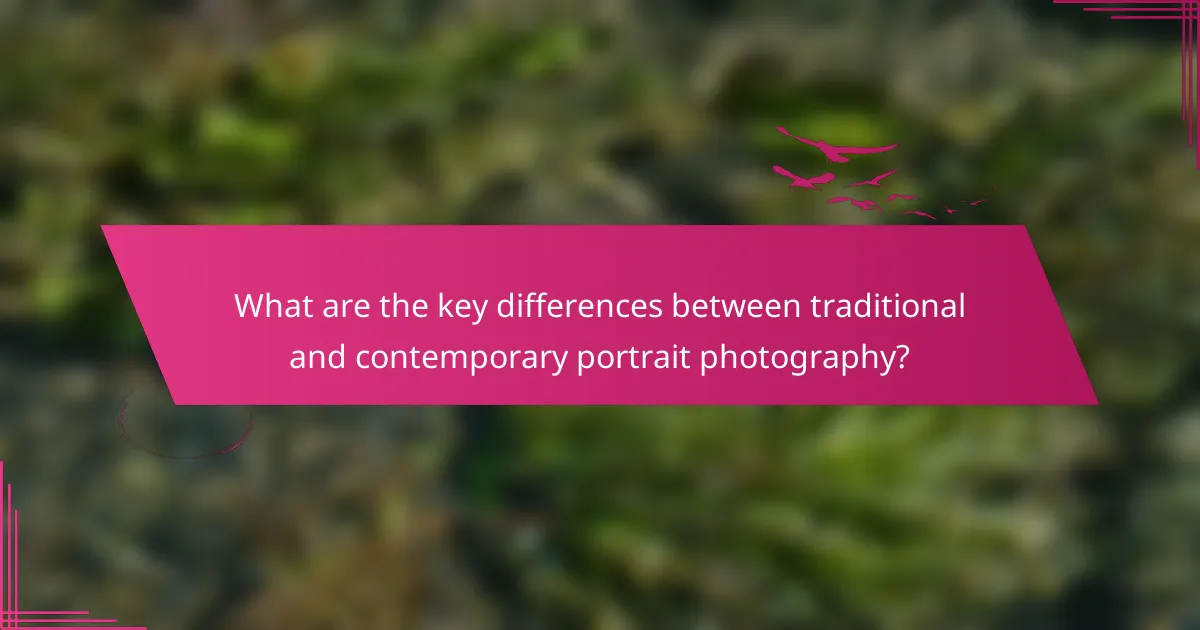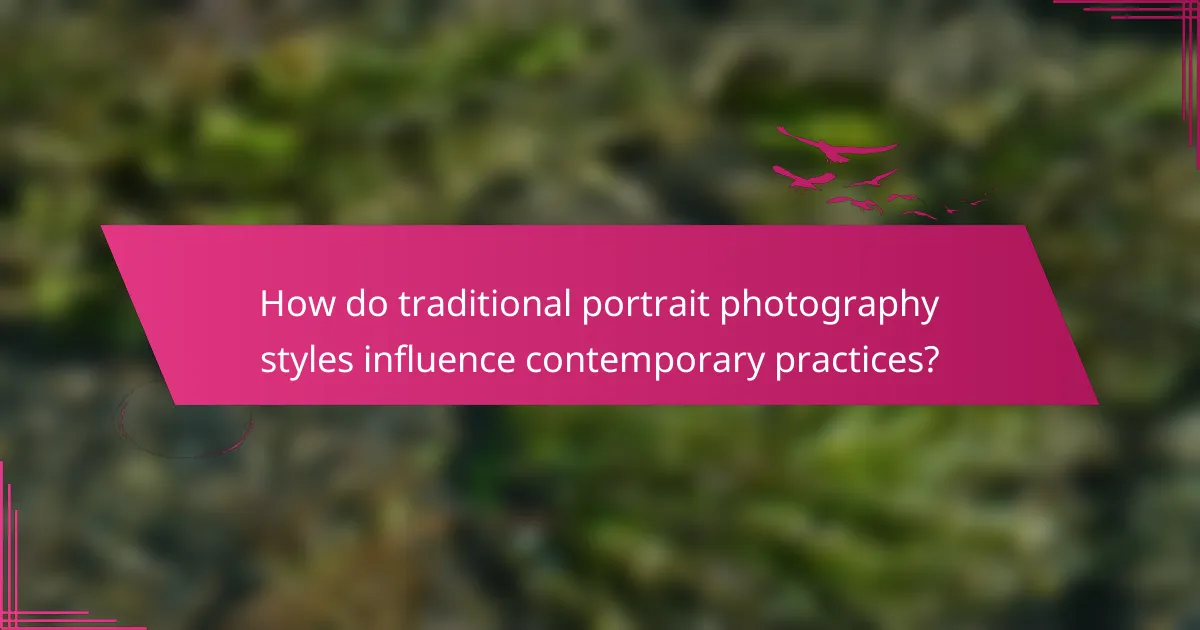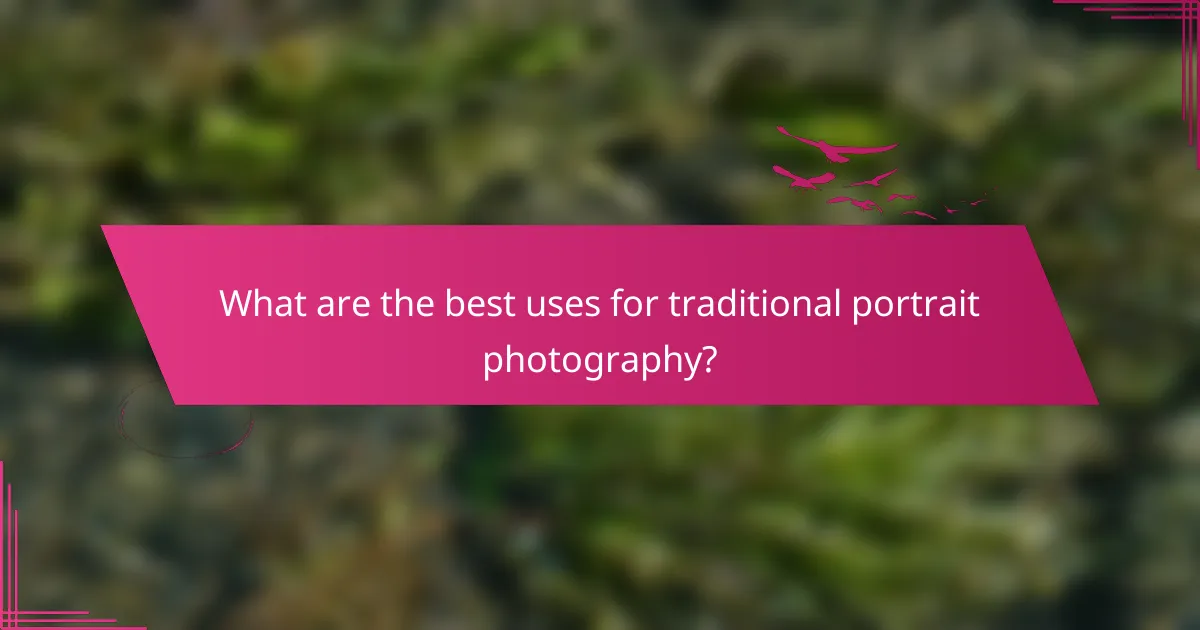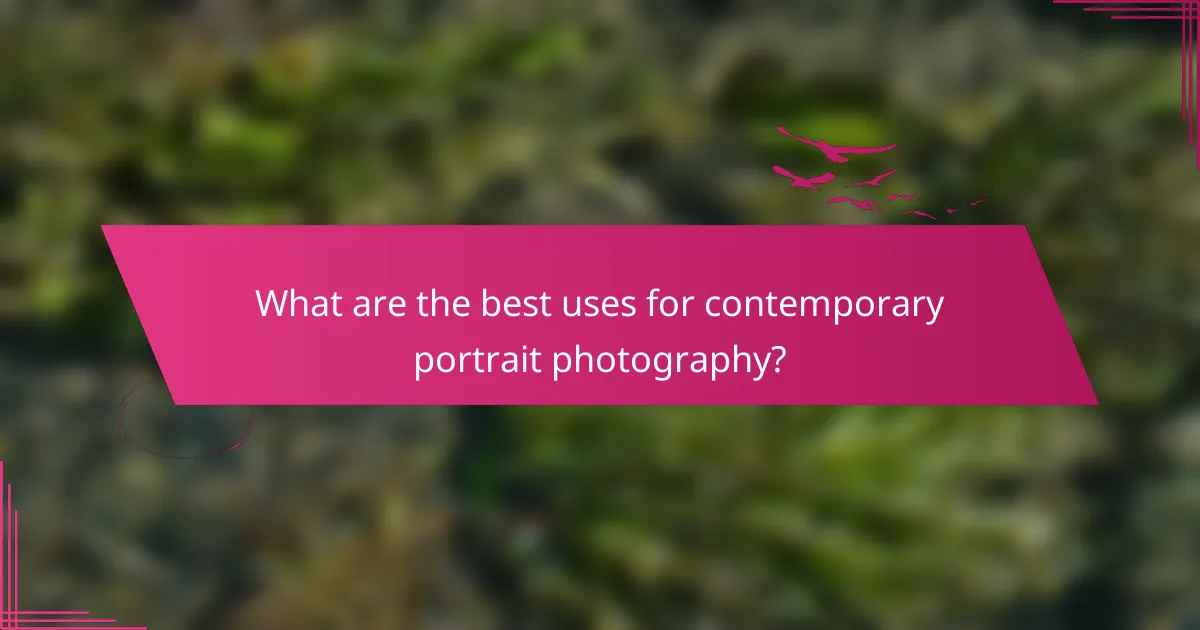Traditional and contemporary portrait photography represent two distinct approaches to capturing subjects, each with its own techniques and aesthetic values. While traditional photography emphasizes formal poses and classic styles, contemporary photography embraces innovation and modernity, catering to diverse audiences and purposes. Understanding these differences is crucial for photographers and clients seeking to convey specific messages through their portraits.

What are the key differences between traditional and contemporary portrait photography?
Traditional portrait photography focuses on classic techniques and formal poses, while contemporary portrait photography embraces modern styles and innovative approaches. Each style serves different purposes and appeals to various audiences, making understanding their differences essential for photographers and clients alike.
Focus on techniques
Traditional portrait photography often employs established techniques such as posed compositions and formal backgrounds. These methods aim to create a timeless quality, emphasizing the subject’s features and expressions in a controlled environment.
In contrast, contemporary portrait photography utilizes a broader range of techniques, including candid shots and dynamic compositions. This approach allows for more spontaneity and creativity, often capturing the subject in their natural environment or engaging in activities that reflect their personality.
Use of technology
Traditional portrait photography typically relies on film cameras and studio lighting, which can produce high-quality images with a classic feel. Photographers often use manual settings to control exposure and depth of field, resulting in a polished final product.
Contemporary portrait photography, on the other hand, frequently incorporates digital technology, including high-resolution cameras and editing software. This allows photographers to experiment with various effects, retouching, and post-processing techniques, leading to a more versatile and modern aesthetic.
Stylistic approaches
In traditional portrait photography, the style is often characterized by formal attire, classic poses, and neutral backgrounds. This creates a sense of elegance and sophistication, making it suitable for formal occasions such as weddings or corporate events.
Contemporary portrait photography embraces a diverse range of styles, from vibrant colors and bold patterns to minimalistic designs. This flexibility enables photographers to tailor their work to the subject’s personality and the intended message, making it appealing for personal branding and social media use.
Subject interaction
Traditional portrait photography usually involves a structured interaction between the photographer and the subject, where the photographer directs poses and expressions. This can create a sense of formality but may also lead to stiffness in the final images.
Conversely, contemporary portrait photography encourages a more relaxed interaction, allowing subjects to express themselves freely. This approach often results in more authentic and engaging portraits, as the photographer captures genuine emotions and moments.
Lighting methods
Traditional portrait photography often utilizes soft, diffused lighting to create flattering images. This can be achieved through the use of softboxes or natural light, ensuring that shadows are minimized and the subject’s features are highlighted.
In contemporary portrait photography, lighting techniques can vary widely, from dramatic contrasts to colorful gels. Photographers may experiment with different light sources and angles to create unique effects, enhancing the overall mood and storytelling of the portrait.

How do traditional portrait photography styles influence contemporary practices?
Traditional portrait photography styles significantly shape contemporary practices by providing foundational techniques, poses, and aesthetics. These influences can be seen in how modern photographers blend classic elements with innovative approaches to create unique portraits.
Historical techniques
Historical techniques in portrait photography include the use of natural light, careful composition, and specific camera settings that emphasize the subject’s features. Many contemporary photographers draw inspiration from these methods, often incorporating soft lighting and shallow depth of field to evoke a timeless quality. Understanding these techniques can enhance the storytelling aspect of modern portraits.
Classic poses
Classic poses in traditional portraiture often involve subjects positioned in a way that conveys formality and character. These poses, such as the three-quarter turn or seated profile, are frequently adapted in contemporary photography to maintain a sense of elegance while allowing for more relaxed expressions. Photographers should consider the emotional tone they wish to convey when selecting poses.
Timeless aesthetics
Timeless aesthetics in portrait photography often feature muted color palettes, soft textures, and a focus on the subject’s eyes. Contemporary photographers may integrate these elements to create a sense of nostalgia or to highlight the subject’s personality. When aiming for a classic look, consider using vintage props or backgrounds that complement the overall theme of the portrait.

What are the best uses for traditional portrait photography?
Traditional portrait photography is best used for capturing timeless images that emphasize formality and connection. It is particularly effective in settings where the subject’s personality and the context of the moment are paramount.
Formal events
Traditional portrait photography shines at formal events such as weddings, graduations, and corporate gatherings. These occasions often require a polished look, where the photographer captures the essence of the event and the emotions of the participants.
When planning for formal portraits, consider the venue’s lighting and background. A well-chosen backdrop can enhance the overall composition and provide a sense of elegance. Ensure that subjects are dressed appropriately to match the event’s tone.
Family portraits
Family portraits are a classic use of traditional photography, often taken to commemorate milestones or reunions. These images can capture the bonds between family members, showcasing their relationships and shared history.
For effective family portraits, choose a location that holds significance for the family, such as a home or a favorite park. Coordinate outfits to create a cohesive look, but avoid overly matching attire to maintain a natural feel. Aim for a relaxed atmosphere to help subjects feel comfortable and authentic.
Professional headshots
Professional headshots are essential for personal branding and networking, making traditional portrait photography a key tool in career advancement. A well-executed headshot conveys professionalism and approachability, which can significantly impact first impressions.
When taking headshots, focus on good lighting and a neutral background to keep the attention on the subject. Encourage subjects to adopt a confident yet relaxed posture. It’s advisable to use high-resolution images suitable for both online profiles and print materials, ensuring versatility across platforms.

What are the best uses for contemporary portrait photography?
Contemporary portrait photography is best used for capturing modern expressions of identity, personality, and style. It is particularly effective in creative projects, social media content, and fashion photography, where visual storytelling plays a crucial role.
Creative projects
Contemporary portrait photography is ideal for artistic endeavors, allowing photographers to explore unique concepts and styles. This type of photography often incorporates elements like dramatic lighting, unconventional poses, and vibrant colors to convey emotions or narratives.
When planning a creative project, consider the theme and message you want to communicate. Collaborating with models or artists can enhance the creative process, leading to innovative outcomes that resonate with audiences.
Social media content
In the realm of social media, contemporary portrait photography shines by providing eye-catching visuals that engage followers. High-quality portraits can enhance personal branding and attract attention on platforms like Instagram, Facebook, and TikTok.
To maximize impact, focus on authenticity and relatability in your portraits. Experiment with different styles and settings to find what resonates best with your audience, and maintain a consistent aesthetic to strengthen your online presence.
Fashion photography
Contemporary portrait photography is a cornerstone of fashion photography, showcasing clothing and accessories in a visually compelling manner. This style emphasizes the model’s personality while highlighting the fashion being presented.
When shooting fashion portraits, consider the latest trends and how they can be incorporated into your work. Utilize various locations, props, and poses to create dynamic images that not only display the fashion but also tell a story about the brand or collection.

How to choose between traditional and contemporary portrait photography?
Choosing between traditional and contemporary portrait photography depends on your specific needs and preferences. Traditional photography often emphasizes classic poses and settings, while contemporary styles focus on modern aesthetics and creative expression.
Client needs assessment
Understanding client needs is crucial when selecting between traditional and contemporary portrait photography. Consider what the client values most—timelessness and formality or creativity and trendiness. Conducting a thorough consultation can help clarify their vision and expectations.
Ask clients about the purpose of the portraits, such as whether they are for personal keepsakes, professional branding, or social media. This insight will guide the choice of style that best aligns with their goals.
Event type considerations
The type of event can significantly influence the choice between traditional and contemporary portrait photography. Traditional photography is often preferred for formal occasions like weddings, graduations, or corporate events, where classic poses and settings are more appropriate.
Conversely, contemporary photography suits casual or creative events, such as family gatherings, art showcases, or lifestyle shoots. The atmosphere and intent of the event should dictate the style to ensure the portraits resonate with the occasion.
Budget implications
Budget is a key factor when choosing between traditional and contemporary portrait photography. Traditional photography packages may include more extensive editing and printing options, which can increase costs. Expect to invest in quality prints and albums that reflect the classic style.
Contemporary photography can offer more flexible pricing, often with digital packages that allow clients to choose how they want to use their images. Assess the budget and discuss options with the photographer to find a solution that meets both style and financial constraints.

What are the pricing ranges for traditional and contemporary portrait photography?
The pricing for traditional and contemporary portrait photography varies significantly based on factors such as location, photographer experience, and session length. Generally, traditional photography tends to be more affordable, while contemporary styles can command higher fees due to their artistic complexity and production value.
Average costs for traditional photography
Traditional portrait photography typically ranges from around $100 to $500 per session. This price often includes a set number of edited images and may cover studio time or location fees. Photographers with more experience or a strong portfolio may charge at the higher end of this spectrum.
When considering traditional photography, it’s essential to clarify what is included in the package. Some photographers may offer prints or digital files as part of the session fee, while others may charge extra for these services. Always ask for a detailed breakdown of costs to avoid surprises.
Average costs for contemporary photography
Contemporary portrait photography usually falls within the range of $300 to $1,500 per session, depending on the photographer’s reputation and the complexity of the shoot. This style often involves creative concepts, elaborate setups, and post-processing work, which can increase the overall cost.
When budgeting for contemporary photography, consider additional factors such as location fees, props, and makeup artists, which may not be included in the initial quote. It’s advisable to discuss your vision with the photographer to ensure that the final product aligns with your expectations and budget.
